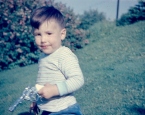Yep, that’s me. A rootin’, tootin’ cowboy during one of my earlier summer adventures. He’s much cuter than I am now–quite a character too!
Speaking of characters, inserting characters into works of fiction and then speaking through them in dialog is a fascination to me as a reader and a difficult ordeal as a writer.
I have watched TV sitcoms and dramas that were easily seen as successful, or not, solely based on the chemistry of the selected cast. Obviously the writing must be good and the character credibility must be apparent, but the interplay, timing and transitions between the chosen characters can instantly attract audiences or lose appeal just as fast. I find that works of fiction play out much the same. There is a chemistry that must be developed between all the characters in your book. It actually begins by choosing eye-catching, memory-banking names. I have read books where I have had to flip back several pages to be reminded who was who. Characters must also have a back story that allows credibility for all of their actions and behaviors. It helps if the reader can identify the character’s philosophy and attitudes. And finally, the dialog must belong to the character and not the writer, as though the writer were merely recording what the character is saying. Putting all of your characters together so that the chemistry produces the necessary draw is the magic we, as writers, all beg to offer. It all begins with creating independently interesting characters with believable back stories that the reader can relate to.
All of this is not an easy task. One way to attempt good character development is to mirror characteristics from people you know. Not exact replicas, but hybrids of personalities, appearances and tones that yield a unique specimen for your book. It’s like blending plums and apricots to get a pluot, (a real fruit). Even more difficult though is the back story. If you don’t know the blended personalities well, creating a back story can appear stilted, lacking depth and color (as in contrast, nature and complexion). You can be as creative as you like but you will need some contextual bracketing for your creative process, i.e., characters you have read, seen on TV, interacted with in business or met socially.
Another way to invent the back story is to dissect your own personality to find the other people living within then develop that part of you, inserting the product into the genome of your character.
How do you develop your characters?

The only character that I develop; is constantly myself.
I like that you point toward drawing on character from actual experience. I think this is a great exercise- perhaps a paramount practice in authorship. Certainly a requirement for me; a photographer. I do consider myself a type of author, and at times an actor.
When I am out photographing I may encounter any number of different individuals. On a given day or at a particular location I witness numerous possibilities wheeling about. Here, within a given group of passersby, I may actually only react and attempt a photograph of a miniscule selection. Ultimately, when I look back at an image which contains particular subject form (which I consider very much likened to character in any story) I think; what was it about this ‘one’ that struck me then, to capture, and again to save in print; to make memorable for others; it’s something visual and in fact I believe actual.
You’re hitting on something important when you mention chemistry, but in photographic predicament it appears the key chemistry somehow exists in a balance between who I am (me) and how the others (they) are in some type of authentic exchange.
Aside from that, I believe TV sitcoms and dramas are idle forms of popular entertainment. And that the writing that exists by them perpetuates a spoon-fed stagnation in an audience. These programs tend to truncate the possibilities that can exist in great forms of story telling. It seems to me that the best ‘stuff’ stems directly from actuality. I often find that what I deem as great fiction carries more truth in a form of inference and observation.
Outside ‘fiction’ Most any other forms of writing or photography, save some types of documentary, appear to work against elements of so called truth. I like especially that the sake of things are entirely real and that by simply changing a name or a time, they may become categorically “fiction.” However, if you or I really know ‘types,’ that is to say that if we are some-how already acquainted with the nuance in a glance, a place, or a perpetual plot then these elements become memorable because they are, in ways, true to us – they can become more true in that way– they bring us back there. There see, to save, to somehow to know.
LikeLike
Thank you for your well thought out reply and your interesting application of character development that stems from the eye of a photographer rather than from the hand of an author. An author builds a frame and places there any story he wishes to dream while a photographer sees the character, the place, the moment and adds his unique frame to tell the proper story.
LikeLike